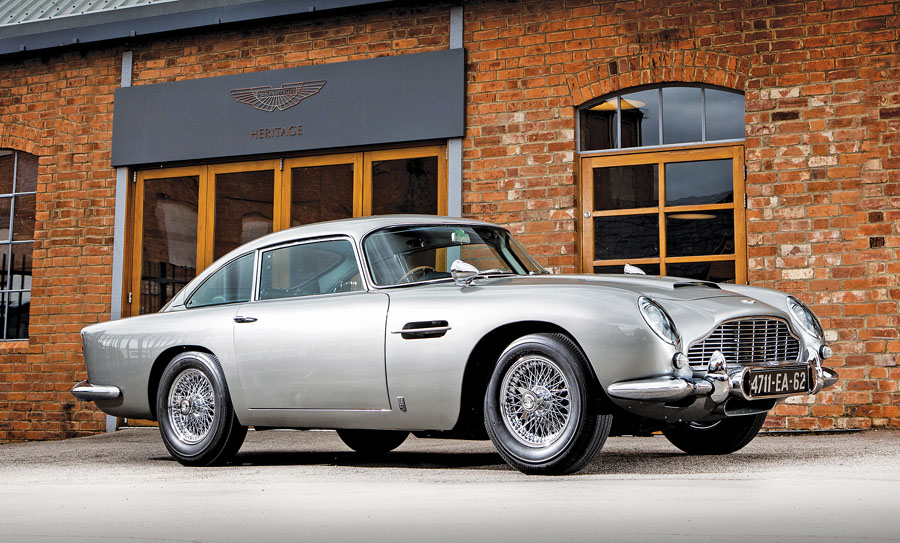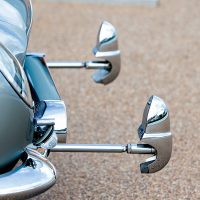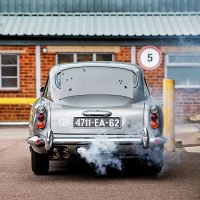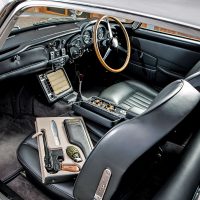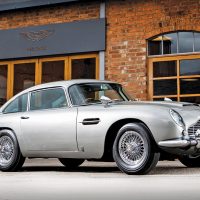SCM Analysis
Detailing
| Vehicle: | 1965 Aston Martin DB5 Bond Movie Promo Car |
| Years Produced: | 1964–66 |
| Number Produced: | 886 coupes (plus 123 convertibles and 12 station wagons) |
| Original List Price: | $14,000 |
| SCM Valuation: | $789,500 |
| Tune Up Cost: | $500 |
| Distributor Caps: | $81 |
| Chassis Number Location: | Plate on right side of scuttle |
| Engine Number Location: | On left of cylinder block next to alternator |
| Club Info: | Aston Martin Owners Club, Drayton St. Leonard, Oxfordshire OX10 7BG, +44 1865 400400 |
| Website: | http://www.amoc.org |
| Alternatives: | 1962–68 Maserati Sebring, 1963–68 Ferrari 330 America GT 2+2, 1966–68 Lamborghini 400GT 2+2 |
| Investment Grade: | A |
This car, Lot 111, sold for $6,385,000, including buyer’s premium, at RM Sotheby’s “An Evening with Aston Martin” in Monterey, CA, on August 15, 2019.
Let’s get one thing out of the way — this is not a true Bond movie car.
Yes, it was part of the razzmatazz surrounding the U.S. opening of “Thunderball” in 1965, but it never appeared in any of the James Bond films — unlike the last genuine film-star example that RM sold in London in 2010 for $4.6 million.
This is a movie promo car, nothing more, nothing less.
Well, actually… it is a bit more these days.
Bond history — and gadgets
During its extensive restoration at Roos in Switzerland, all the special-effects gadgets as seen on the original film car (which, ironically, was stripped of them afterwards) were made to work. The gizmos include front and rear hydraulic overrider rams on the bumpers, Browning .30-caliber machine gun concealed in each front wing (fender), wheel spinners as tire slashers, a retractable bulletproof screen at the rear, an in-dash radar-tracking scope, oil-slick and smoke-screen dispensers, revolving license plates and an ejecting passenger’s seat.
Although they were never seen in the film, there’s a telephone in the driver’s door and weapons storage under the driver’s seat.
All of this stuff makes our subject car perhaps the most complete “Bond car” ever. Bear in mind that for filming, the gadgets on the original car were only needed to perform once per shot; on this one they actually work — and carry on working.
Of the two original “Goldfinger” cars, both borrowed from Aston Martin and returned after filming, only one was fitted with the spy gadgetry. The other DB5 was standard and used for drive-by shots.
Chassis DP2161, actually the DB4 Series V-based DB5 prototype, is the original “Goldfinger”/”Thunderball” effects car. The removed gadgets were later refitted, but it was stolen from a hangar in Florida in June of 1997 and has never been seen since.
It is now the holy grail for Bond DB5 detectives.
A U.S. collector owned the “driving” car, DB51486R, for more than 40 years, and it’s seldom seen in public. This is the car RM sold in London in October 2010 for $4,608,528 to another U.S. collector, Harry Yeaggy.
The promo cars
Such was the demand for the 007 DB5 to appear around the world to publicize the films that a further two cars that never appeared on screen, DB52008R and DB52017R, were bought. Eon Productions and Aston Martin Works fitted the 007 gadgets.
In 1969, the film production company’s financier quietly offered the two promo Bond DB5 cars for sale after their movie promotion careers ended. British collector Anthony (now Lord) Bamford bought the two cars as a pair.
Bamford quickly sold 2017R — it’s now in the Louwman Museum in the Netherlands. However, Bamford kept 2008R — our subject car — until 1970, when he sold it to B.H. Atchley, the owner of the Smoky Mountain Car Museum in Pigeon Forge, TN, where it remained for 35 years on display — but was started regularly.
In January 2006, this car was sold on behalf of the Smoky Mountain Car Museum at RM’s Scottsdale Auction for $2,090,000.
Our subject car then underwent a four-year restoration that included making all 13 James Bond gadgets work as designer John Stears intended.
2017R was offered for sale in 2013 by Aston specialist RS Williams for £3 million, which was then about $4.6 million.
Other Bond DB5 cars
We’ve now accounted for all of the “Goldfinger” cars.
There are more Bond DB5s.
Three more (DB52187R, DB51484R and DB51885R) were painted up for “Goldeneye.”
Another DB5 (DB51399L) appeared in “Casino Royale.”
The DB5 in “Skyfall” (DB5/2007R) was bought from RM’s Don Rose at the 2010 Battersea sale prior to its silver paint job for $385,000.
One of the “Goldeneye” cars, 1885R, sold for $2,580,887 at Bonhams’ Goodwood Festival of Speed auction on July 13, 2018.
Our subject car
Where does that leave us on the value of our never-appeared-on-film Bond DB5?
History has shown that cars that have actually appeared with 007 on screen bounce to about 10 times their “real” value — that is to say 10 times the price of a standard example.
That even applied to one of the two 1976 Lotus Esprits used in “The Spy Who Loved Me.” The one that barely appeared in the finished film — it served mostly as a camera platform — sold for $165,020/£111,500 (£100k bid) at Bonhams Olympia in 2008.
Back then, £10k/$16k got you a nice stock Esprit S1.
Later, the Bond submarine Esprit “Wet Nellie” fetched £616k/$990k when it was sold at RM’s Battersea sale in September 2013.
Although I don’t agree, 2008R is generally considered a real “Goldfinger” car — one of the four — as it was part of the 007 promotion and marketing at the same time as the actual screen stars, even though it never appeared in a Bond movie.
Does that make it more authentic and desirable than one of the five or so tatty cars sprayed up to appear in the later productions — and which only dilute the rarity of the original Bond cars?
Just making all the effects work on this one must have cost a bomb (sorry!).
When 1486R sold in London for $2.9 million, that represented seven or eight times the market value of a stock DB5 at that time. DB5 sold prices in 2019 have realistically settled at around £600k — even though many of us think that number should start with a 5 — or around $800,000, with untouched original or exceptional restored cars (like this one) a little more, but generally under $1 million.
If you take that as a yardstick, the selling price here represents seven or eight times the current market value of a DB5 — just about the same boost ratio achieved by 1486R nine years ago.
So the Bond multiplication factor holds steady. If you consider this a real Bond car, the money is therefore right. If you don’t (I don’t), then the buyer overpaid.
(Introductory description courtesy of RM Sotheby’s.) ♦
